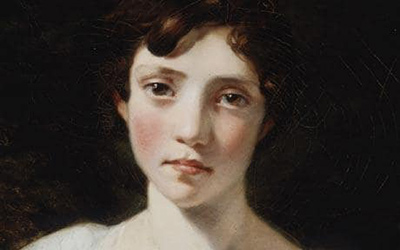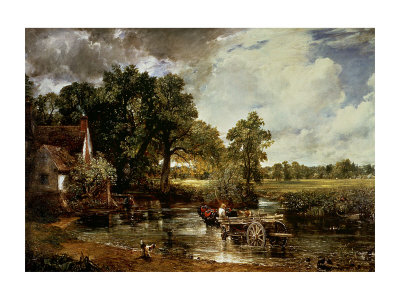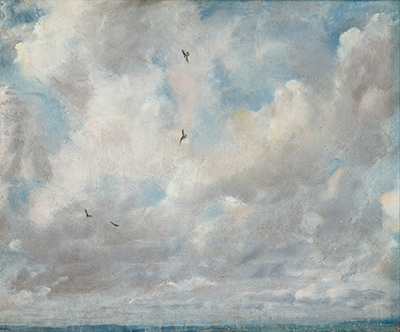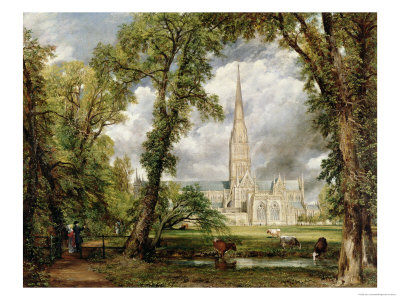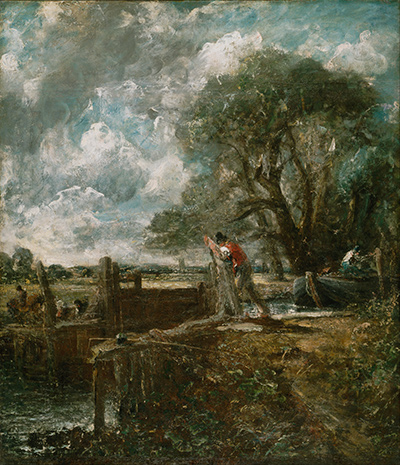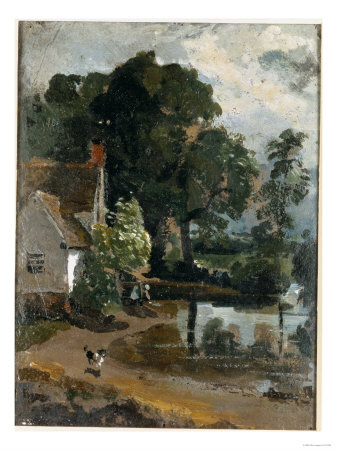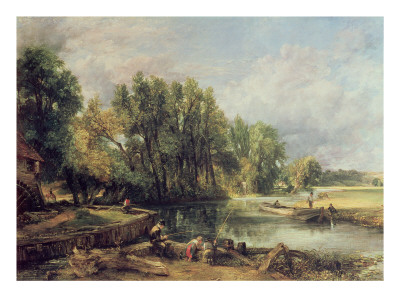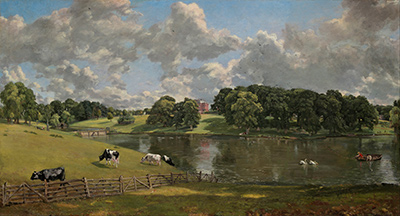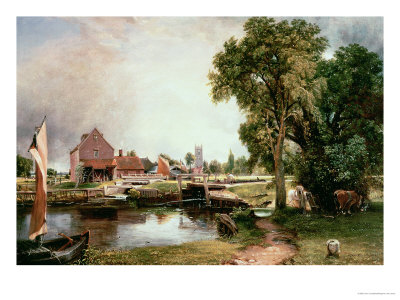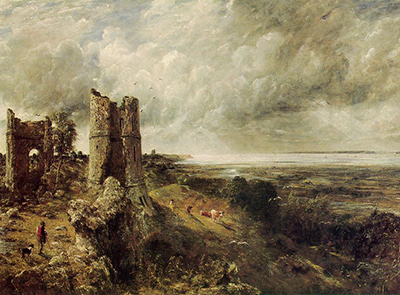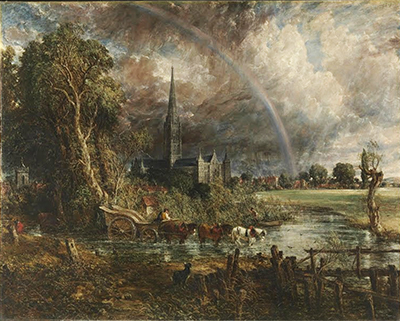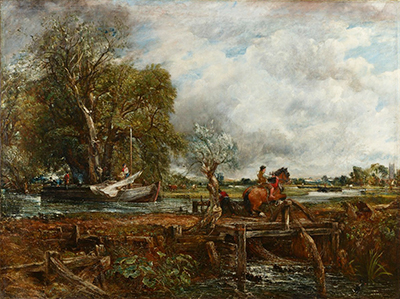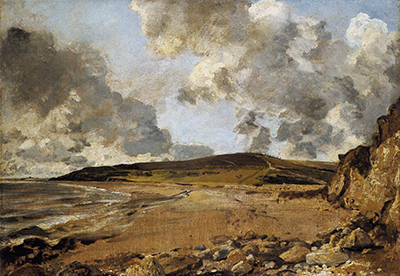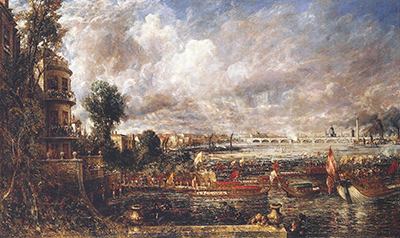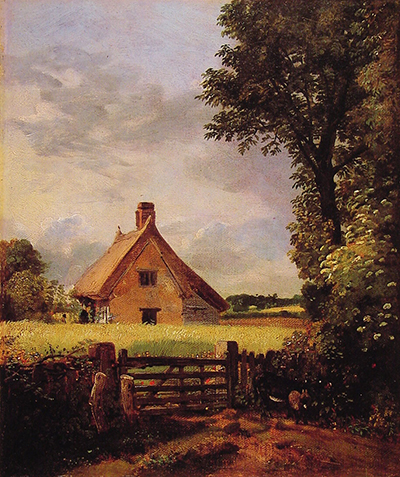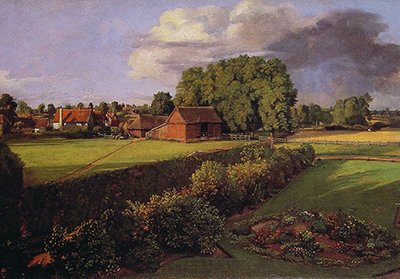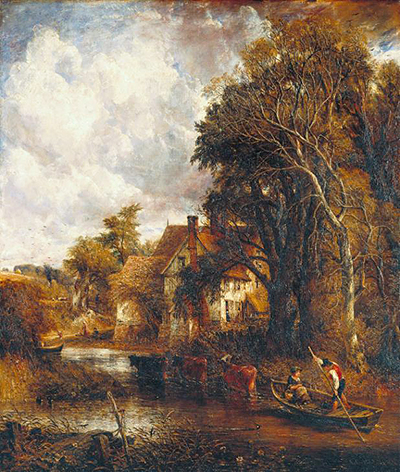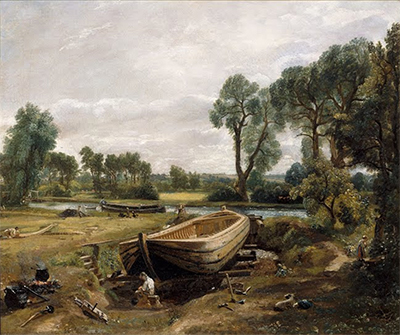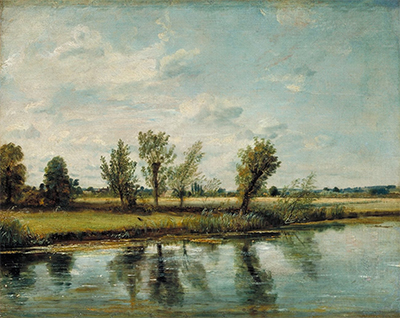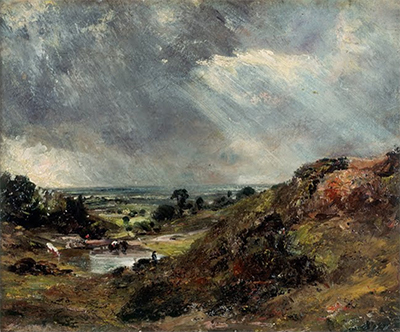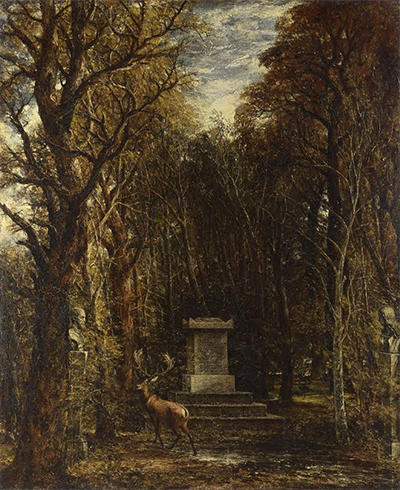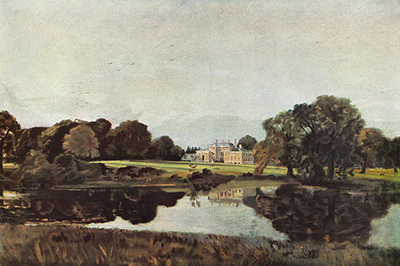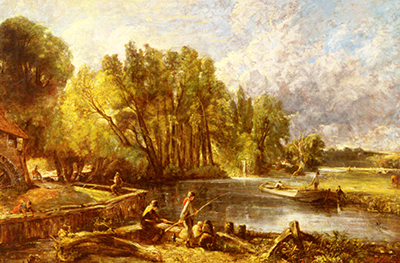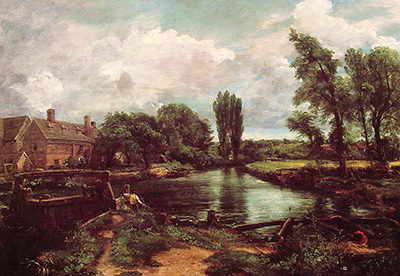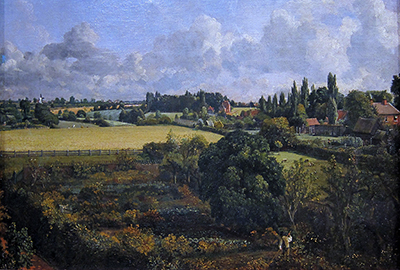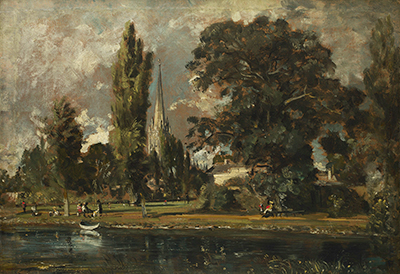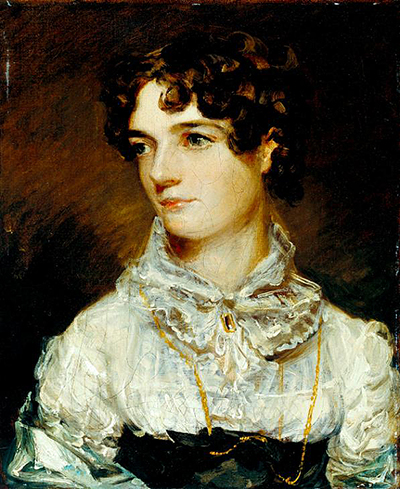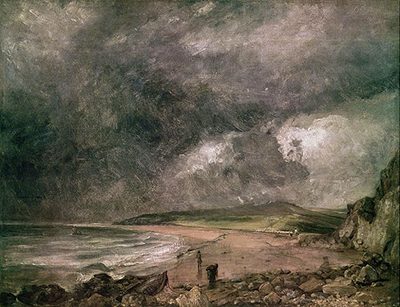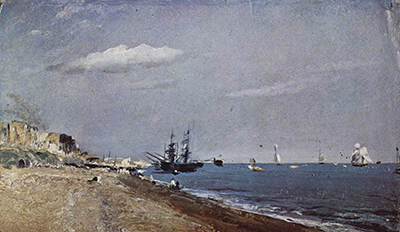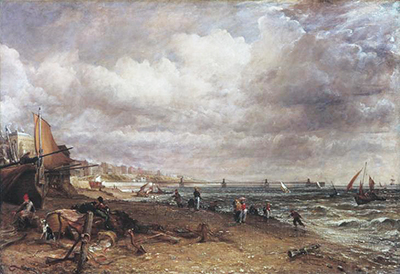Born in the English county of Sussex in 1776, John Constable is today regarded as one of the greatest of the English Romantic painters.
Academic Respect in France
While his paintings are now some of the most highly valued and best-loved in Britain, Constable largely failed to achieve critical and commercial success in his home country during his lifetime. He was, however, highly regarded in France at the time, enjoying a degree of commercial success and influencing the French Romantic painters as well as the Barbizon school of painters.
Unique within the Romanticist Movement
Though inspired by the paintings of such celebrated artists as Thomas Gainsborough, Claude Lorrain and Peter Paul Rubens, among others, Constable took a unique approach to his landscape paintings.
While many of his contemporaries depicted romanticized landscapes featuring imposing ruins, sublime mountains, or exotic locations, Constable was somewhat radical in preferring to represent more prosaic scenes from the English countryside and in particular, the area around his Suffolk home.
Likewise, he chose to paint scenes in which people interacted with the landscape in an everyday manner, rather than paint imposing but solitary vistas. His paintings depict the social aspect of the countryside as well as the natural beauty of the landscape.
This focus on the ordinary, as opposed to the grandiose, was somewhat unfashionable at the time and likely contributed to his lack of commercial success in England at the time. Another way in which Constable distinguished himself from other painters of the Romantic period was in his use of vibrant yet naturalistic colour.
Bold brushwork
He also used strong, sweeping brush strokes and applied thick layers of paint in order to create a more realistic sense of light and movement. This too likely contributed to his lack of popularity with English buyers of the time, as they viewed the technique as rough and unpolished.
It was not just the Suffolk landscape that inspired Constable's paintings. While living near Hampstead Heath, which at the time was outside of the city of London, Constable painted a series of about 100 cloudscapes. Not only was Constable fascinated by the ever changing light and movement of the British sky, he read widely on the subject of meteorology and cloud formation and this, in turn, enabled him to approach his cloud studies in a scientific as well as artistic manner. These cloud sketches were painted in watercolour as well as in oil.
Additional genres besides Landscape Art
Though best known for his oil on canvas landscapes, Constable also painted portraits and worked with watercolours. Though portraiture was not a passion for Constable, who found it dull in comparison with the landscape painting he was passionate about, it provided an income and his portraits are well regarded. His 1816 portrait of his wife, Maria Bicknell is well regarded and today is exhibited in Tate Britain.
Likewise, he had some success with watercolours, most notably his 1835 painting of Stonehenge. Most of Constable's best-known paintings, however, are landscapes of the area around his childhood home in the Stour River valley in Suffolk, the area around Salisbury, including Stonehenge and Salisbury Cathedral, and his paintings of Hampstead Heath, where he lived from 1821.
Some of what are now his best known and most highly regarded works failed to find English buyers at the time they were exhibited. These include The Hay Wain, which is arguably one of the most famous of all English landscape paintings. Likewise, though Flatford Mill, would influence French painters such as Millet, Corot and Daubigny, it was never sold during Constable's lifetime. It was only in 1829, at the age of 54, that Constable was finally elected a full member of the Royal Academy. John Constable paintings feature the beautiful English countryside and are amongst the best known art works to have come from the UK. This website features all the best paintings from Constable as well as plenty of information on the life of the artist as well and also discussion on buying your own reproduction prints of the originals included throughout this page.
Constable and Turner were respected British artists whose careers were almost entirely based on landscape scenes which took advantage of the natural beauty which surrounded them and combined that with their own creative talent and passion for the outdoors. Constable himself was brought up in Suffolk, East Anglia and featured that consistently within his career. Later on, as Constable's reputation spread, so did the locations from where he would capture his paintings. John Constable paintings and featured throughout this website, with images of the best originals that we could find from his considerable career.
The painting above is The Haywain which is certainly the best known of all his works, though many other landscape works are also well respected and worth checking out. There is a fuller list of his oil paintings and pencil sketches further down the page and all images are accompanied by links to where you can buy your own reproduction copies of the originals for your own home. John Constable and JMW Turner were amongst the finest members of the Romanticist art movement which was crucial in developing traditional art thinking onwards towards the contemporary styles which we enjoy today.
Constable came about at a time when landscape painting was not entirely part of the mainstream, certainly not as much as it is today, and his passion and strong character combined with great technical ability helped to push forward this style of art that is now very much taken for granted as a major interest. John Constable was someone who did not achieve financial stability as an artist although he did at least become recognised as a member of the Royal Academy at 52 which is a significant moment for any British artist, particular during this period. Much of Constable's qualities in his paintings came from the supreme drawing skills which he had that helped him to plan his works carefully and accurately before adding the oil colours afterwards. Several of his sketches are also included here and these show off these illustrative techniques.
John Constable has managed to keep his reputation strong all the way up to the modern day and this is in part due to the rise in popularity for landscape paintings, with most seeing him as one of the most skilled exponents, certainly within England. It is important that Constable was not just talented at this art genre, but was also extremely passionate and strong willed, helping to sell the art form through his hard work, talent and great belief in it.
Salisbury Cathedral
Salisbury Cathedral is a stunning painting which features intertwined trees in the foreground which circle that charming traditional architecture of the cathedral which sits in the background across a calming blue sky scene. Constable produced several works of the cathedral from several different angles and was known to have enjoyed his time in Salisbury which at the time was an important town within England but perhaps lesser so now.
John Constable was later to be attracted to London where he needed to be in order to develop his career as far as possible because of the connections that he could build up as well as the opportunities it gave him to bring his work to much larger audiences who were always interested in the newest artists. Although Constable always sold more paintings within France he did succeed in London, particularly when you consider that several of his best known paintings were created here including Hampstead Heath and Waterloo Bridge.
Dedham Lock and Mill
Dedham Lock and Mill is another John Constable landscape painting which takes in a small canal alongside buildings with in a highly rural setting which proves exceptionally popular with many art lovers around the world who warm to the natural surroundings of the British countryside which is characterised by it's shades of greens which make it ideal for certain traditional oil painters such as Constable plus fellow romanticist William Turner.
Cornfield
Cornfield and Dedham Vale are the two next best known works by Constable after his Haywain classic, and you can see Cornfield above. The artist liked to capture locations close to where ever he was living at the time and felt that choosing places personal to him was the key to achieving success within the romanticist movement. Few can argue with this when considering the qualities of his paintings and the success that he achieved. The area around his home in Suffolk has in fact become known as 'Constable Country' in honour of this.
List of Famous John Constable Paintings
Please see below for a summarised list of the best Constable paintings that are featured throughout this website.
- Dedham Vale
- Landscape: Ploughing Scene in Suffolk
- Boat-building near Flatford Mill
- Golding Constable's Flower Garden
- Golding Constable's Kitchen Garden
- Portrait of Maria Bicknell, Mrs. John Constable
- Wivenhoe Park, Essex
- Flatford Mill (original title Scene on a Navigable River
- Weymouth Bay
- The White Horse
- Hampstead Heath
- Stratford Mill
- The Hay Wain
- View on the Stour near Dedham
- Salisbury Cathedral from the Bishop's Grounds
- Seascape Study with Rain Clouds
- Brighton Beach
- The Leaping Horse
- The Cornfield
- Dedham Vale
- Hadleigh Castle
- Salisbury Cathedral from the Meadows
- The Valley Farm
- Arundel Mill and Castle



